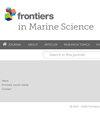Deeper eelgrass meadows are refugia from disease and environmental stressors
IF 3
2区 生物学
Q1 MARINE & FRESHWATER BIOLOGY
引用次数: 0
Abstract
Eelgrass (更深的大叶藻草地是疾病和环境压力的避难所
大叶藻(Zostera marina)在世界范围内创造了有价值的生物多样性栖息地,但受到环境压力和疾病的综合威胁。我们在2017-2019年夏季调查了美国华盛顿州圣胡安群岛成对的潮间带和潮下草甸的海草消耗性疾病,以确定疾病如何随深度、温度和盐度变化。我们预计,与温度和盐度变化较大的浅层潮间带草甸相比,环境条件更稳定的较深草甸疾病减少。利用机器学习算法来检测和量化疾病,我们测量了高疾病水平和草地密度的巨大变化,特别是在2018年较温暖的夏季。日平均原位温度和遥感温度捕获了暴露于变暖的情况,尽管原位温度更好地确定了特定地点的季节性温度范围。与潮间带草甸相比,潮下草甸的最高原位温度低近14°C。在为期3年的研究中,浅层潮间带草甸的疾病严重程度是较深的潮下草甸的2.24倍,是2018年变暖期间的1.39倍。因此,一些潮下草甸可以作为抵御环境和致病压力的有价值的避难所。较低的大叶藻密度也与严重程度增加有关,这表明疾病与草地斑块之间存在联系。温度和盐度也是较高疾病的关键预测因素:流行率和最高海面温度共同变化,严重程度和盐度范围也共同变化,表明这些环境因素可能不同地影响海草消耗性疾病的风险和进展。我们的工作强调了潮下大叶藻草甸和环境条件更稳定的地点作为多种应激源的避难所的价值,这些应激源应被视为疾病的不同驱动因素。
本文章由计算机程序翻译,如有差异,请以英文原文为准。
求助全文
约1分钟内获得全文
求助全文
来源期刊

Frontiers in Marine Science
Agricultural and Biological Sciences-Aquatic Science
CiteScore
5.10
自引率
16.20%
发文量
2443
审稿时长
14 weeks
期刊介绍:
Frontiers in Marine Science publishes rigorously peer-reviewed research that advances our understanding of all aspects of the environment, biology, ecosystem functioning and human interactions with the oceans. Field Chief Editor Carlos M. Duarte at King Abdullah University of Science and Technology Thuwal is supported by an outstanding Editorial Board of international researchers. This multidisciplinary open-access journal is at the forefront of disseminating and communicating scientific knowledge and impactful discoveries to researchers, academics, policy makers and the public worldwide.
With the human population predicted to reach 9 billion people by 2050, it is clear that traditional land resources will not suffice to meet the demand for food or energy, required to support high-quality livelihoods. As a result, the oceans are emerging as a source of untapped assets, with new innovative industries, such as aquaculture, marine biotechnology, marine energy and deep-sea mining growing rapidly under a new era characterized by rapid growth of a blue, ocean-based economy. The sustainability of the blue economy is closely dependent on our knowledge about how to mitigate the impacts of the multiple pressures on the ocean ecosystem associated with the increased scale and diversification of industry operations in the ocean and global human pressures on the environment. Therefore, Frontiers in Marine Science particularly welcomes the communication of research outcomes addressing ocean-based solutions for the emerging challenges, including improved forecasting and observational capacities, understanding biodiversity and ecosystem problems, locally and globally, effective management strategies to maintain ocean health, and an improved capacity to sustainably derive resources from the oceans.
 求助内容:
求助内容: 应助结果提醒方式:
应助结果提醒方式:


